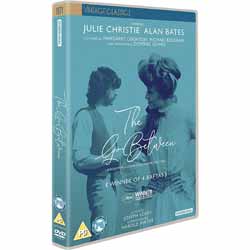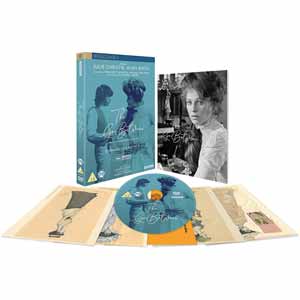|
Click here to return to the main site. DVD Review
An English Edwardian summer in 1900, the last summer of Queen Victoria’s reign, is the main body of The Go-Between, based on the novel by L. P. Hartley, bookended by a modern era wrap-around two generations later. A young boy, Leo, in the throes of puberty, is invited home by his schoolmate, Marcus, to his family’s Norfolk estate where Leo becomes besotted with Marcus’s older sister, Marian. Marian is betrothed to a Viscount but is having a secret passionate affair with local farmer, Ted Burgess. The lovers enlist Leo to be their ‘postman’ to carry back and forth love letters and appointments for assignations. Leo becomes submerged in his role as go-between and mystified Mercury-messenger for the secret of the two backed beast. Enveloped by a prologue and epilogue with tantalizing flash-forwards throughout, the old Leo returns to Norfolk to carry one more message from the aged Marian nearly a half century later. Marian is the luscious Julie Christie, Burgess is the consummate Alan Bates and they are surrounded by an exalted ensemble including Margaret Leighton, Michael Gough, Edward Fox and the perfect Michael Redgrave as the old Leo. The young actor Dominic Guard plays the young Leo. All are quintessentially superb. Edwardian society is presented as confidently charted waters for the patron class with nary a ripple of discord or poor form. For screenwriter Harold Pinter and director Joseph Losey this is a working class artist’s opportunity to plumb beneath the surface to the truth under the hulls and rudders of a class ‘to the manner born.’ Jealous writers (there’s no better way to put it) like Kenneth Tynan maligned the picture because it misses the ‘stupendously effortless authority’ of Edwardian society and depicts them as leading quietly desperate lives (love starved) in their world of the well-to-do. Pinter is snidely pilloried for his recurrent theme of destruction of innocence, of youth and of love, his dissection of delusional class pride. He is probably the greatest screenwriter to ever work in film. His lean and spare dialogue is always in tension with an undercurrent of dread and apprehension. Two fine examples of this talent for double layering are his wrongly disrespected scripts for The Quiller Memorandum (1966) or The Last Tycoon (1976). Losey and Pinter were a great creative partnership with six films to their credit, each respecting the other’s domain without violation or Besserwisser (the personality who knows better) conceit. Tynan was accused by another great writer, John Osborne, of intellectual spivvery. In this case, the indictment sticks. He could not have written this screenplay with or without his most satisfying ass spanking. The cinematography by Gerry Fisher is consistently elegant and painterly under what the creators found to be difficult weather conditions. Its countryside hazes recede into 19th century landscape tableaus presaging Kubrick’s Barry Lyndon (1975). No doubt that director had studied Fisher’s work very carefully. Joseph Losey is worthy of a film-by-film study. (For denizens of this site, he did the two best Hammer films ever: X The Unknown [1956] and These Are the Damned [1962] along with the multiple well known classics which everyone knows, to which I always like to add his 1951 noir remake of Fritz Lang’s M and The Boy With Green Hair [1948]) Losey facilitates Fisher to frame confidently and subtly without the self conscious graphic composition of Hitchcock, Wyler or Hawks. The sublime work of Ingmar Bergman and Sven Nykvist springs to mind. But it is Christie who cannot be praised enough for her work in front of the camera. Her complexity of character borne with and without dialogue is a study in the art of screen acting. It’s a prime example of why she’s… well, why she’s Julie Christie. She is the gaiatic tide that raises all ships. StudioCanal has rescued this classic from near oblivion, scanning the original 35mm negative where possible, supplemented by alternative sources where necessary, in 4k, 16 bit resolution, including over 200 hours of painstaking hands on frame-by-frame reconstruction, to reconstitute a new print for their elite Vintage Collection. I can assure you it looks better than it did 48 years ago. They are to be thanked. 10 John Huff
Buy this item online
|
|---|


